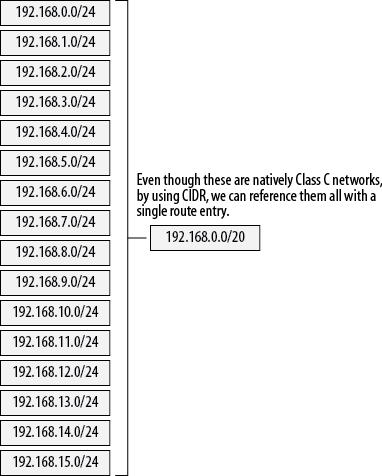CIDR
If you deal with large numbers of IP networks, like ISPs do, Classless Internet Domain Routing (CIDR) is a most useful tool. While VLSM has had a dramatic impact on IP space allocation within corporate networks, CIDR has had an equally impressive impact on public Internet networks allocated to ISPs.
CIDR is sort of the inverse of VLSM: whereas VLSM prescribes rules for subdividing networks, CIDR prescribes rules for referencing groups of networks with a single route statement.
Aggregating routes may seem like a solution looking for a problem if youâve only ever dealt with small or medium-size corporate networks, but, rest assured, it provides a real benefit. Usually, small or medium-size companies use one of the private IP networks described by RFC 1918. If a company uses the entire 10.0.0.0/8 network and subdivides it to maximize efficiency, each of these subdivisions is technically a subnet. While VLSM deals with subnets, CIDR deals with groups of major or classful networks. Figure 36-4 shows how a single route statement can reference 16 Class C networks. The route is called an aggregate route or a summary route.

Figure 36-4. CIDR route aggregation
On Internet-attached routers with full tables, the routing tables may contain hundreds of thousands of routes. Anyone can see them at any time by connecting to one of many publicly available route servers. To illustrate this point, ...
Get Network Warrior, 2nd Edition now with the O’Reilly learning platform.
O’Reilly members experience books, live events, courses curated by job role, and more from O’Reilly and nearly 200 top publishers.

